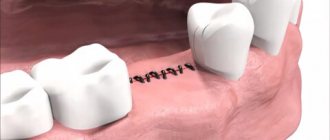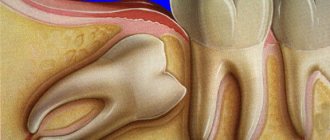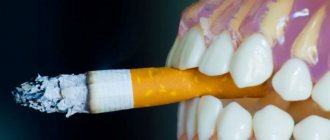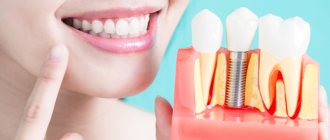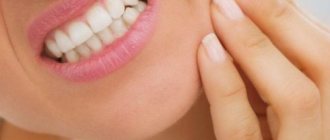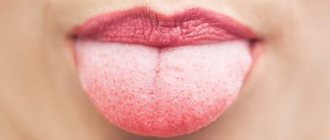Suturing after tooth extraction is a standard procedure. The doctor closes the hole when indicated or at the request of the patient. Tightly fixed edges of the wound speed up the healing process, relieve pain, and reduce the risk of complications. Immediately after the surgical operation, the dental surgeon explains the rules of hygiene - how to care for the socket, what to do if the sutures come apart after tooth extraction.
Indications for suturing after tooth extraction
In surgical dentistry, it is customary to suture the socket of the removed unit if:
- wisdom teeth were extracted and figure eights were removed;
- there is a risk of severe bleeding - according to patient examinations or as a preventive measure;
- Extirpation of impacted and dystopic teeth was performed;
- the removal was difficult - the crown part of the tooth was severely destroyed or the roots of the extracted unit were significantly curved.
All surgical removal operations, when the dentist cuts the gum and injures the jaw tissue, involve suturing the edges of the resulting hole.
Also, the socket of the extracted tooth is sutured after the implant is installed in it. The procedure is carried out as part of a one-stage implantation with delayed prosthetics. An implant surgeon combines two operations. After extracting the tooth and assessing the condition of the socket using a control x-ray, the doctor implants a dental implant, which will subsequently become a support for a permanent dental crown. The operation is performed only after preliminary preparation, since the patient must undergo a full examination and hardware diagnostics.
Types of seams. Types of threads
In each case, when the dental surgeon sutures the gum, he decides which suture to use.
Seams can be intermittent or continuous .
The first type is more common and is characterized by the overlapping of separate, unrelated stitches (pictured below), and each is secured with its own knot.
This maintains the integrity of the fabrics, even if one of the stitches fails and falls off.
There is continuous suturing. All stitches are made with a single suture thread, securing them with a common knot. It's faster, but any damage to one stitch can ruin the entire thread construction.
Pain after suturing the hole: pathology and norm
Pain in the suture area is normal. Injury to the gums due to major surgery causes pain, especially in the first days.
The patient must understand that tooth extraction means damage to the ligaments that hold the tooth in the gum, rupture of nerve fibers and blood vessels. During the operation, the pain is blocked by the anesthetic, but after the anesthesia wears off, discomfort is observed at the site of the sutures.
The following sensations should not cause concern:
- aching pain for the first 24 hours after removal;
- slight swelling of the tissues in the surgical area
- discomfort and slight pain when opening the mouth;
- short-term increase in body temperature.
In rare cases, after a complex removal, the patient may experience chills, facial swelling, purulent discharge, cough, and nausea. These signs should not be ignored - it is better to immediately seek help from a specialist.
Briefly about the introduction of dental implants
To install a metal structure into the bone tissue, it is necessary to make an incision in the mucous membrane. At the end of the surgical intervention, suturing is required. If the outcome of the operation is favorable and there are no consequences, the surgical threads are removed after about 10 days.
The operation process itself is completely painless for the patient, this is thanks to high-quality anesthetic drugs. A little pain is possible only during the rehabilitation period. If you follow all the doctor’s recommendations, all troubles can be avoided, however, not always everything depends only on the patient’s behavior.
Types of suture materials in surgical dentistry
In dental clinics, different types of threads are used to fix the edges of the sockets during tooth extraction:
- Synthetic, self-resorbable due to hydrolysis reaction. These are threads with a hypoallergenic composition that guarantee reliable fixation of the wound edges for about a month.
- Natural, absorbable, enzyme-based surgical suture material. The stitches disappear in 10-100 days, and the thread segments are safely removed from the human body.
- Synthetic regular threads. Made from silk, nylon, polyester. They require mechanical removal after complete healing of the hole.
Types of seams
There are generally two types of suture materials used by dentists. The difference between them is that one type “resolves” (dissolves), the other does not.
Seams that dissolve
Slit stitches (absorbent stitches) have the advantage that they do not need to be removed. Your body breaks them down and gets rid of them. Such sutures will easily dissolve without damaging the gums. Doctors often use these stitches, as they say: why injure the wound by removing stitches if they can disappear on their own. These types of sutures are sometimes called "catgut" sutures or simply "gut" sutures.
How long does it take for them to dissolve? The time taken for disintegration depends on the type of material. Intestinal sutures remain intact for 5-7 days, chronic treatment lasts about 9-14 days. Some synthetic materials can last for a couple of weeks.
How long does it take for threads to dissolve?
Special threads for suturing are very convenient, since when using them there is no need to further injure the surgical site. But not all patients know how long they need to wait for the process of thread resorption to complete.
As a rule, if high-quality suture material is used, not a trace will remain of it within 20–30 days after the operation.
It should be noted that the threads simply fall apart, and then the person unnoticed swallows them. There is no discomfort or danger if thread residues enter the stomach.
The advantage of using such material for suturing is that with them there is no need for an additional trip to the doctor. However, a week or two after surgery to remove a wisdom tooth, you should still visit the dentist to make sure that the surgical intervention did not lead to complications, for example, to an inflammatory process.
The exact time after which the seams will completely disappear is impossible to determine. But there are still approximate deadlines for each type of material.
In medical practice, 2 types of threads are widely used:
The first type, namely classic catgut, has been used for decades. This material has been used for more than a century, but recently it has begun to be replaced by new types of retainers. Classic threads can hold seams from 10 to 140 days. Over time, enzymes will begin to attack them, which will lead to their complete breakdown and elimination by the body. Nowadays, catgut is very often used when removing wisdom teeth. This operation is rarely done without stitches, but if you put them in, it’s very difficult to remove them. Absorbable sutures will be very useful.
How long do you need to walk with stitches?
The patient's actions depend on the type of suture material used by the doctor. If the doctor used a non-absorbable option, a control appointment is scheduled after 7-10 days. During the examination, the surgeon assesses the speed of healing and the condition of the wound. Decides on the need to remove sutures.
The procedure is quick and atraumatic. The thread is cut into small segments and painlessly removed from the gums. If the patient experiences discomfort and anxiety, the doctor can use topical anesthesia.
Self-absorbing sutures disintegrate on their own in about three weeks. The patient may not notice the material disappearing from the wound. Especially if healing is going well and the hole is not bothering you.
Complications: what to look out for
Even a sutured hole can become a source of problems or inflammation. The patient monitors the condition himself and should consult a doctor if any alarming symptoms appear:
- Heavy bleeding - for a day or more.
- Continuous pain - throbbing, especially severe at night or while eating.
- Swelling is gumboil in the area of tooth extraction.
- Redness is not only a change in the color of the gums, but also redness on the face in the projection of the extraction area.
- Blood in saliva - in the first three days after surgery.
- Increase in body temperature.
The listed symptoms indicate pathological processes and require urgent consultation with a doctor. After the examination, the doctor will prescribe treatment and decide on re-suturing.
Recommendations for oral care after surgery
After applying stitches, you must follow a number of rules:
- Do not pick at the wound again, do not touch it with your hands or tongue
- Don't eat too fatty foods
- It is better to give up solid foods - apples, nuts, seeds
- Do not try to remove stitches yourself
- Rinse your mouth with Rotokan solution and other means prescribed by your doctor.
- It is recommended to brush your teeth with a new toothbrush
- It is not recommended to use dental floss near the suture site.
- Don't drink alcohol
- Do not use medications that thin the blood
- Do not drink coloring or too hot drinks - coffee, black tea, lemonade, soda
- Do not try to stop the bleeding if intense bleeding occurs using self-prescribed medications. It is better to go to a 24-hour dental clinic or call a doctor at home.
What to do to prevent sutures from coming apart after tooth extraction
To prevent the sutures from coming apart prematurely, the patient needs to follow a few simple rules. Among them:
- Do not pry, touch or try to pull out the seams with your hands, toothpicks, or improvised objects.
- Avoid eating for the first 2 hours after surgery, do not smoke for 3-24 hours.
- Carry out all mandatory hygienic procedures for caring for the oral cavity, while brushing your teeth with extreme caution.
- Avoid eating hard, hot and cold foods in the first days after removal.
- Replace rinsing with antiseptic baths, when the medicinal composition is kept in the mouth for 1-1.5 minutes and spat out.
Compliance with all recommendations guarantees fast and safe healing. Ignoring advice can provoke wound infection, suppuration and suture separation, and the development of an inflammatory process.
How to remove sutures on the gums
Before removing stitches:
- The surgeon will treat the oral cavity with an antiseptic.
- Examine the mucous membrane of the oral cavity: it is necessary that there is no pain, fever, redness, swelling, and no fluid or pus is released from the wound area.
- The thread is cut with a special dental instrument. When the seam is continuous, the cut will be in several places; if it is intermittent, then all the stitches will be cut in half.
- Using fingers or tweezers, the surgeon will pull out pieces of thread and check how well the scar is formed on the wound.
After removing the stitches, the patient will rinse their mouth with an antiseptic.
For 1–3 days, unpleasant sensations in the jaw and gums are possible when moving.
The wound after tooth extraction heals completely within 2–3 weeks. In young people this process is faster. The sockets of single-rooted teeth can heal completely on the 14th day, multi-rooted ones - by the 20th day after surgery.
In case of purulent complications, healing will be delayed for a week for a single-rooted tooth, and 2 for a multi-rooted one.
The more traumatic the operation was, the larger the volume of tissue that was subjected to intervention, the longer the healing.
The surgeon still removes the absorbable sutures so that they, being on the gums for a long time, do not provoke inflammation.
Removing the suture material too early may prevent a clot from fully forming in the wound. In this case, inflammation is also possible.
Sometimes patients get in the way of the threads, and the question arises of the sutures from the gums on their own, at home What to do if the surgeon is far away, and it’s impossible to tolerate when the threads become hard and rub against the tongue or gums, causing irritation of the mucous membrane?
In principle, the stitches can be removed by the patient himself. But this is fraught with infection in the wound.
At home, you must follow all the rules of asepsis and antisepsis; you cannot keep your instruments sterile. Safe removal of the threads used to suture the gum wound is only possible by a dentist.
